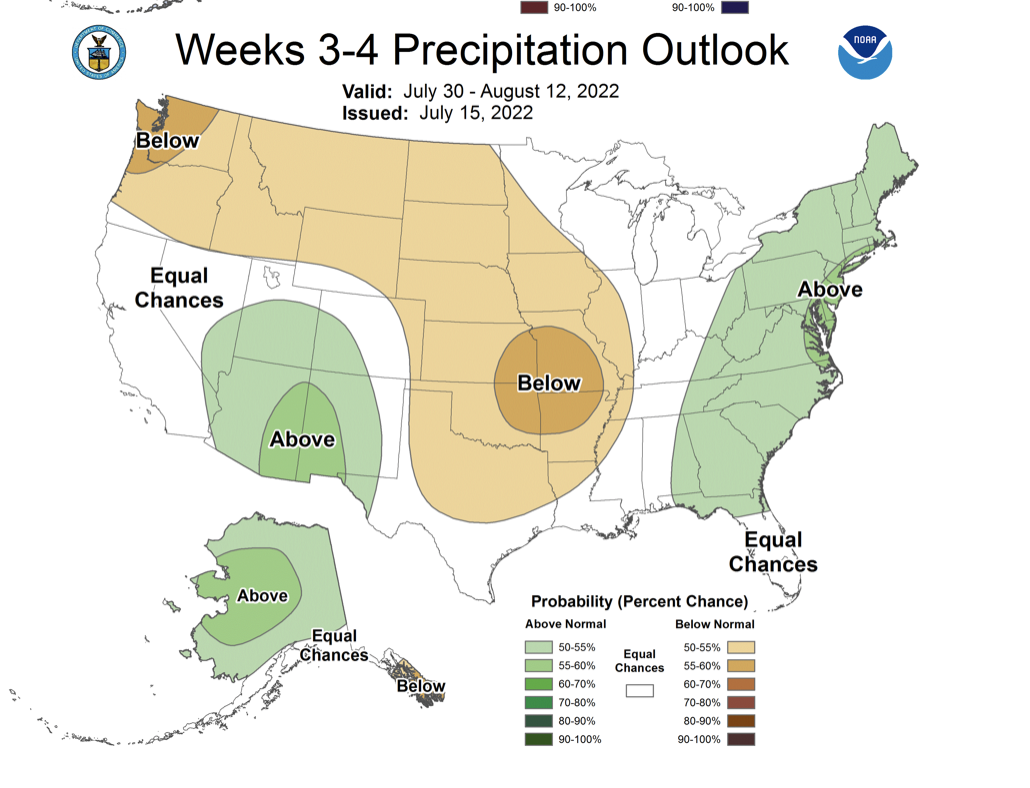Extreme Heat And High Nighttime Temps Now Hitting At A Crucial Time For A U.S. Corn Crop Planted Late
Crop Progress 071922
Extreme heat is painting the worst-case scenario for the Western Corn Belt this week. USDA meteorologist Brad Rippey is concerned about not only the duration of the relentless heat in the most recent weather forecast, but the impact it could have at a key time for late planted corn currently pollinating.
The historic heatwave in the West already created record temps this weekend. Glasgow, Montana reached 108 degrees on Sunday. 100 degree heat hit Lawton, Oklahoma.
Rippey says the extended heat could possibly set a few monthly or all-time records the Great Plains.
For the states seeing triple digit heat enter the picture this week, temperatures could continue to crush daily records west of the Mississippi River, which could not only cause crop pollination problems and pose a threat for grain fill in corn, but some of the country’s soybean crop as well.
“I cannot play this out any worse, I think, in my mind of how this heatwave is playing out,” says Rippey. “Here in mid-to-late July. We've got corn starting to pollinate. We've got soybeans blooming and even starting to set pods in parts of the lower Midwest. And we have this disastrously timed heatwave, it is spreading out of the Great Plains, it's going to be moving across the western Corn Belt and into the mid-south at what I think is a very inopportune time for corn and soybeans.”
Read More: Grains Pull Back Tuesday with Change in Weather, Livestock Open Mixed
Just How Far Behind is the Crop?
The latest crop progress report from USDA shows while crop conditions held steady this week, the maturity of the crop is behind. Approximately 37% of the corn crop is silking, which is 11 percentage points behind average. Kansas has 31% of its crop silking as of Sunday, which is 19 points slower than the average pace. 65% of Missouri’s crop is in that stage, which is 7 points behind. Nebraska sits at 45% in the silking stage. South Dakota is only at 13%.
The U.S. soybean crop isn’t as far behind in terms of maturity. USDA says 48% of the soybean crop is blooming, which is 7 points behind normal.

August is always a key time for soybeans, but with a late planted corn crop at a crucial stage right now, Rippey is currently concerned about the impact it will have on the western Corn Belt’s corn crop most.
“We're looking at late week to weekend temperatures that are going to hit 100 degrees or higher in many areas of the southwestern Corn Belt states, including Nebraska, Kansas, into Missouri and even parts of Iowa, especially the southern and western parts of the state,” says Rippey. “And given the timing on that, and the fact that a disproportionate amount of that crop is moving into pollination, or blooming in this mid-to-late July period, I don't think we could write a worse scenario for the crop.”
Read More: AccuWeather Thinks Next Week's Heat Wave Could Scorch 30 to 45 Million Bushels of Corn
The other weather issue is the fact the crop won’t get much of a break from the heat with high nighttime temperatures.
“Unfortunately, a complicating impact here is that we're not going to get much nighttime relief temperatures at night are going to be in the 70s to near 80 degrees. And that adds another layer of complexity to this entire pollination and blooming situation that could be detrimental to the crop,” says Rippey.
The latest look at National Weather Services’ three-to four-week outlook shows triple digit heat is expected to last through the week. Longer-range forecasts also strongly suggest heat and dryness to remain a problem west of the Mississippi River for the first half of next month.


“If you look at the six to 10 day, the eight to 14 day, the three-to-four week outlooks, and then we'll have a new set of monthly and seasonal outlooks coming out on Thursday. That'll be a focus just to see what the weather service thinks is going to be the outlook for August. I'm afraid it's going to be very similar to what we're seeing on that three to four week Outlook with a lot more heat parked right over the middle part of the country, bleeding into the western Corn Belt and the Mid South, unfortunately,” he adds.
Yes, July is Supposed to Be Hot... But Not This Hot
July is supposed to be hot, so why is this heat even news? Rippey says it all goes back to how much of the crop was planted late, with 50% of the nation’s corn crop planted in a two-week window and two-thirds planted in just three weeks.
Read More: The Forecast Next Week Is Ugly, So Why Isn't A Weather Rally Now Underway?
“In a typical year, planting took place several weeks earlier,” says Rippey. “So, a lot of it took place in April and early May this year, we were several weeks behind, almost two thirds of the corn was planted during the month of May. That was unusual. We saw our slowest planting pace going all the way back to 2019. Before that 2011 and 2013. So we're on the lower end of the scale for planting progress. We knew all along that if we got this typical to even slightly atypical in terms of the temperatures really rising here. If we got this heat in late July, it would be a problem for the crop. And that's exactly what's happening, unfortunately, is that we staved off the heat for a while in July. But now it's coming roaring in here mid-to-late month.”
Rippey says the bit of good news is the majority of the eastern Corn Belt is expected to escape the heat.
Stay updated on the latest forecasts and weather-related news.







